THE PAINTED LADY OF SACKETT STREET (1958)
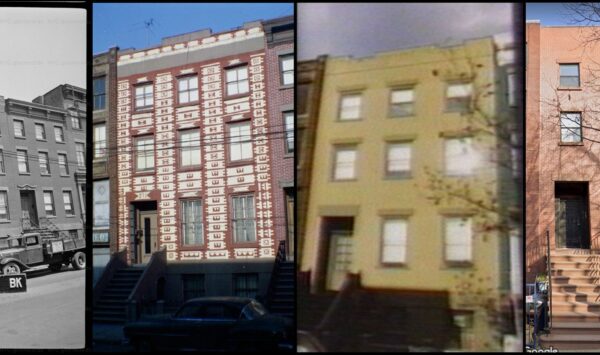
******************************************************************************************************************************** Brownstone Detectives investigates the history of our clients’ homes. The story you are about to read was composed from research conducted in the course of one of those investigations. Do you know the history of YOUR house? ******************************************************************************************************************************** Houses as old as the historic brownstones of New York City have had a lot of time to experience change – change of ownership, change of status, as well as physical change. Much of that change often occurs on the inside of these buildings as their occupancy type changes. The most prevalent change of this type that occurs over time is the change of a property from a single family house to a mutiple dwelling or boarding house. Just outside the Cobble Hill Historic District, sits a much-altered brownstone on Sackett Street between Court and Clinton Streets, No. 275. Constructed pre-1855 as a one-family house it would experience many change over the years. Its original address was No. 160. Its original owner appears to have been William H Perry, a stock broker on Wall Street. By the 1860s, the Forsyth family lived in the Sackett Street rowhouse. Orlando Forsyth was a jeweler who, in the 1840s, had had a showroom on Fulton Street at No. 99. The house would begin taking boarders in the 1870s, continuing at least through most of the 20th century. THE LADY GETS A FACELIFT At face, however, the physical changes of No. 275 seem to be the most striking. While, in its original state, it resembled […]
LIFE IN A HARLEM TOWNHOUSE (1910)
******************************************************************************************************************************** Brownstone Detectives investigates the history of our clients’ homes. The story you are about to read was composed from research conducted in the course of one of those investigations. ******************************************************************************************************************************** No. 65 W. 119th St. in Harlem was owned by Alfred L. Silberstein, whose family brought him to the United States from German when he was three years old. He founded Griffon Cutlery Works. He lived in the brownstone with his wife, 5 children, 3 servants, & his mother-in-law, for roughly 20 years. The family brownstone, according to an ad from the period, was a “three story, high stoop basement dwelling, with extension, butler’s pantry, 10 rooms and two baths, handsomely finished; electric light and parquet floors.” Silberstein would advertise the townhouse for sale a few years later at a value of $20K (although he would take $16K). By 1920 Silberstein was living in one of the new apartment houses in Manhattan located at No. 600 West 157th Street. At this point, he was an importer of cutlery. Follow @BrownstoneDetec Share ———————————————————————————————————————– The Brownstone Detectives Brownstone Detectives is a property research agency. Our mission is to research, document, and save the histories of our clients’ historic properties. From this research, we produce our celebrated House History Books. Each book is fully cited, featuring detailed narratives and colorful graphics, and is designed to bring the history of any house to life. Contact us today to begin discovering the history of your home.
NEW YORK CITY’S IRISH HOUSE OF LORDS (1912)
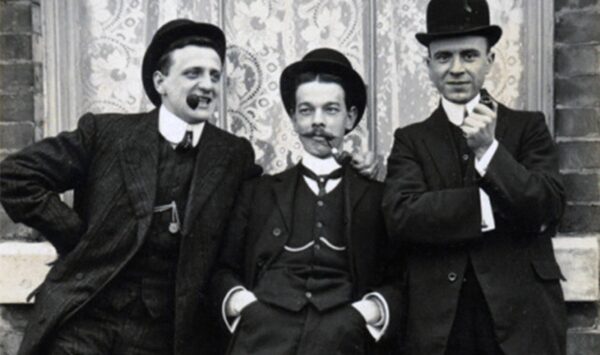
******************************************************************************************************************************** Brownstone Detectives investigates the history of our clients’ homes. The story you are about to read was composed from research conducted in the course of one of those investigations. Do you know the history of YOUR house? ******************************************************************************************************************************** “(New York City) is never the same city for a dozen years together. A man born in New York forty years ago finds nothing, absolutely nothing, of the New York he knew. If he chance to stumble upon a few old houses not yet leveled, he is fortunate. But the landmarks, the objects which marked the city to him, as a city, are gone.” – Harper’s Monthly, 1856 ******************************************************************************************************************************** It was an unassuming ancient wood-frame house – said to be one of the last of its kind in Yorkville – and it was entering its final Fenian days. The building, which had been purchased half a century before in 1860, at the princely sum of $10K, by the then-current owner, John Sheehy, had, through the death of said owner, been forced in 1912 upon the chopping block for sale to the highest bidder. The history of the structure, though, had been more known, in some ways, to the British War Department of the past half century than it had been, generally, to many of the locals of Yorkville where it had stood for more than most could remember. For, it had taken on the fantastical aura of the gathering place of patriots, as well as the auspicious mantel of the “Irish […]
THE VIRUS TAKES A WOMAN MARINE (1918)
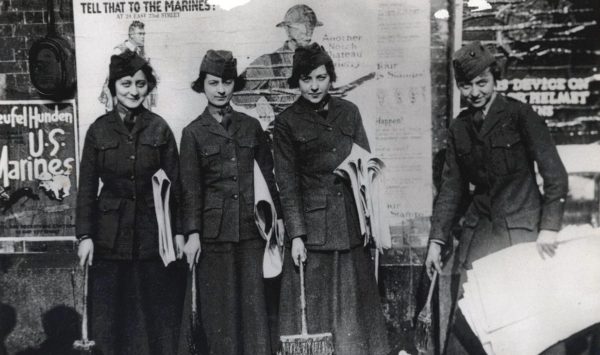
******************************************************************************************************************************** Brownstone Detectives investigates the history of our clients’ homes. The story you are about to read was composed from research conducted in the course of one of those investigations. Do you know the history of YOUR house? ******************************************************************************************************************************** In 2014, The Brownstone Detectives partnered with the New York City Parks Department to help celebrate the lives of the servicemembers of Bedford-Stuyvesant Heights who made the ultimate sacrifice during the Great War. We researched these heroes to locate pictures, stories, and their descendants to be brought together for a ceremony that dedicated a new “Victory and Peace” war memorial at Saratoga Park. This biography tells the story of one of those servicemembers. PROLOGUE In 1918, when the United States was fighting a war overseas, the country was also fighting a conflict back home – influenza. Just as people were dying in the the “Great War” to combat “the Hun,” Americans were succumbing back home to a virus that was leading to their deaths in hospitals. Much like with today’s coronavirus, there were still essential services then that needed to be continued. One of those services was recruiting for that overseas war. One of those recruiters was one of the first woman Marines. She lived on Macon Street in the Bedford-Stuyvesant section of Brooklyn. She came down with influenza while on recruiting duty in Manhattan. And she became the first woman Marine buried with full military honors. This is her story. PVT. LILLIAN MAY BOGEN PATTERSON It would be a mistake […]
HOW YOUR BROWNSTONE LOST ITS SOUL (1915)
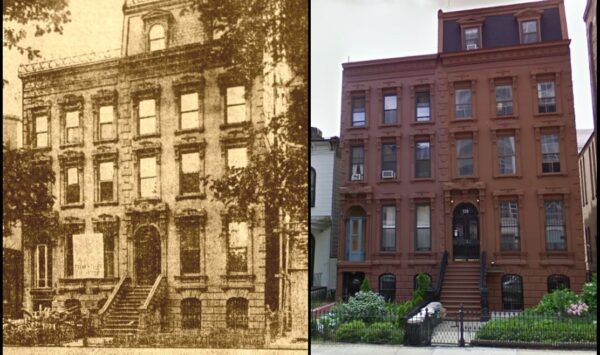
******************************************************************************************************************************** Brownstone Detectives investigates the history of our clients’ homes. The story you are about to read was composed from research conducted in the course of one of those investigations. Do you know the history of YOUR house? ******************************************************************************************************************************** It started just 20 years after construction began on “Brownstone Brooklyn” – our brownstones and townhouses began to lose their “souls.” Constructed in a time when owners needed three and four stories of room for large families, they had, in those times, existed as the epitome of style and class. Now that so much square footage so close to the city center was becoming too dear for so many residents (who did not have families or who needed much less room), builders were beginning to construct large apartment houses that provided all of the necessities of home within a smaller, but more stylish and efficiently laid out, space. Such competition from newer construction caused the formerly beloved brownstone to lose its lucrative “soul.” THE SOLUTION TO ANTIQUITY In 1915, real estate broker Frank Tyler struck upon an idea that turned out to be, in essence, a paradigm change: Take an old inefficient brownstone and turn it into a stylish and updated apartment house. Tyler noticed that “the average three-story and basement dwelling of old-fashioned style” had “become a drag on the real estate market.” Because of “great changes that have taken place in construction, and the popularity of apartment house living,” brownstone owners had been experiencing a decline in the rental […]
BROOKLYN’S ALL GAS KITCHEN! (1914)
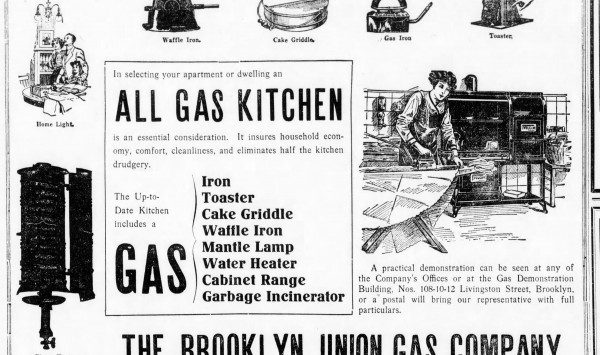
******************************************************************************************************************************** Brownstone Detectives investigates the history of our clients’ homes. The story you are about to read was composed from research conducted in the course of one of those investigations. Do you know the history of YOUR house? ******************************************************************************************************************************** Just like today, gas stoves were once pushed onto Americans with a fury. Fueled by ads, lobbying, and massive amounts of money, the Brooklyn gas company told homemakers that gas was “essential” for “economy, comfort, cleanliness,” and guaranteeing an elimination of “half the kitchen drudgery.” Little did homemakers know, at the time, about the future controversy regarding gas as a health concern in the home. THE FUTURE – GAS! O, Brooklyn Union Gas Company! Thanks to you, my wife can be more efficient in the kitchen with the chemical of the future – GAS! Begun in 1825 as the the Brooklyn Gas Light Company, it became Brooklyn Union around 1895, and remained so until the end of the last century when a merger brought about KeySpan. Imagine! Installing, in 1914, a Gas Garbage Incinerator in your brownstone’s kitchen! That year, the Brooklyn Union Gas Company was pushing their gas appliances not only to heads of households, but they were also targeting “Progressive Business Men” to whom they claimed were attending the “special demonstration of gas industrial appliances at the gas industrial show rooms” at 108-10-12 Livingston Street, known as their “Gas Demonstration Building.” At their showrooms they announced, were “gas engine electric generator sets, automatic gas fuel steam boilers, sanitary bakers’ […]
TO CATCH A MACDOUGAL STREET THIEF (1910)
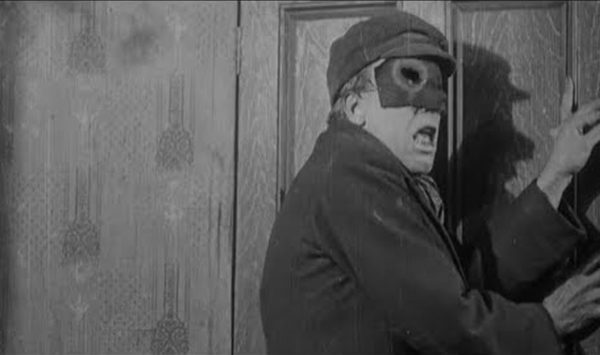
******************************************************************************************************************************** Brownstone Detectives investigates the history of our clients’ homes. The story you are about to read was composed from research conducted in the course of one of those investigations. ******************************************************************************************************************************** When investigating the history of a house, we sometimes come across a jewel that details an event which took place within the structure. The following narrative from 1910 tells a story involving the homeowner of No. 274 MacDougal Street, a rowhouse in the Ocean Hill section of Bedford-Stuyvesant, who happened upon a would-be burglar entering his home through an open window late one night. The homeowner, Charles Ortman, an engineer, had recently moved to the newly-built structure with his small family. Ortman showed a presence of mind not typical of someone faced with an intruder attempting to gain access to his home. Using old newspaper stories, city insurance maps, and census records, we reconstruct the case. Brooklyn Daily Eagle, 5 November 1910 – “Charles Ortman, an engineer last night shot a burglar who was in the act of breaking into his home at 274 McDougal street. The shooting was witnessed by his 12-year-old son, Charles, and by his wife, who had followed him out to the dining room, where the thief’s face had appeared pressed close to the window pane. “Whether the would be intruder was slightly or fatally wounded the police do not know. He had disappeared when a policeman of the Ralph avenue station arrived, in response to a summons from the Ortman home. But there was […]
WHICH LANDMARKS TO DEMOLISH? (1913)
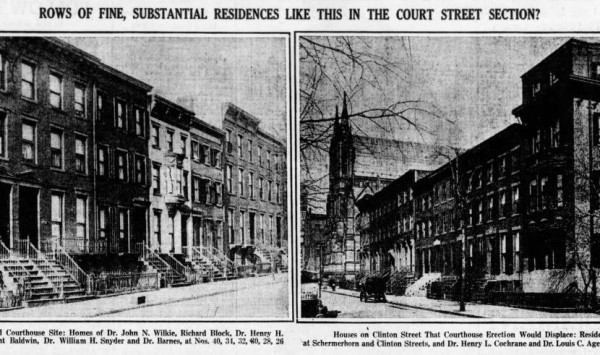
******************************************************************************************************************************** Brownstone Detectives investigates the history of our clients’ homes. The story you are about to read was composed from research conducted in the course of one of those investigations. Do you know the history of YOUR house? ******************************************************************************************************************************** In 1913, Brooklyn was looking to tear down long rows of stately brownstones. These brownstones were “substantial residences” in the “Court Street Section” comprising Nos. 24 to 40 Schermerhorn Street and Nos. 141 to 137 Clinton Street. The owners of these homes, upon discovering that their residences were in the path of the newest Brooklyn courthouse, were, understandably, up in arms. Eminent Domain or no, they were having none of it, and they started a campaign to force the city to locate a building site more suitable. Apparently, these men got to the Brooklyn Daily Eagle, which published this spread showing their houses – along with their names (5 out of the 7 of whom were doctors) – and compared their residences (favorably, of course) to an alternative site that they had seclected comprised of “several blocks of lodging houses, dance halls and the like in the Bridge Plaza District,” asking the question: “WHICH SITE CAN BE BETTER SPARED FOR A COURT HOUSE?” Playing upon the morals of the people of Brooklyn, it would be clear which site would meet the wrecking ball when, the following day, an assemblyman from Brooklyn by the name of Burr announced that the New York State Assembly would soon adopt his bill “taking from the […]
THE EFFECTS OF WAR ON BED-STUY (1918)
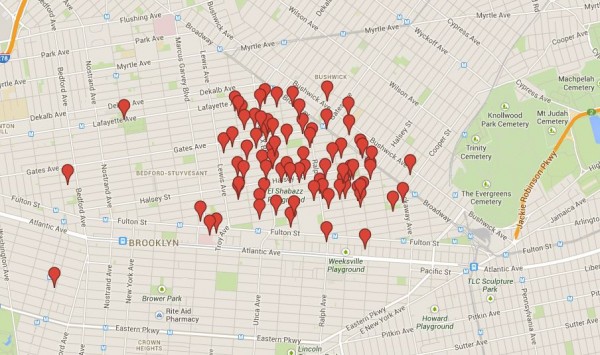
******************************************************************************************************************************** Brownstone Detectives investigates the history of our clients’ homes. The story you are about to read was composed from research conducted in the course of one of those investigations. Do you know the history of YOUR house? ******************************************************************************************************************************** During the brief period that the U.S. was engaged in WWI, the eastern section of Brooklyn’s Stuyvesant Heights section was decimated by its contribution of men to the war effort. Then, it was decimated a second time by the generous contribution it made of many of these mens’ lives. According to the honor rolls of the “Victory & Peace” memorial in Saratoga Park, approximately 105 men (and one woman) from the neighborhood made the ultimate sacrifice. There was a death on nearly every block of the district – often more. The MAP above shows with red pins the locations where some of these men lived – many of them who had left new wives, parents, and families waiting for them back home. The servicemembers, represented on this map by these red dots, never made it back home, though. Most were buried in American Cemeteries in France; some were re-buried here in the U.S. After the war, the Gold Star Mothers pilgrimages began to take place, as thousands of the mothers of these servicemembers made the government-sponsored trips to France in order to visit the last resting places of their children. Today, the specific memories of these citizens who grew up together, went to school together, played, learned, and competed together here […]
THE LION COMIQUE OF 276 CARLTON AVE (1930)
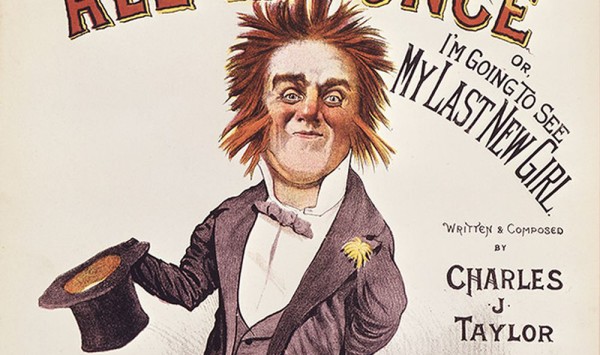
******************************************************************************************************************************** Brownstone Detectives investigates the history of our clients’ homes. The story you are about to read was composed from research conducted in the course of one of those investigations. Do you know the history of YOUR house? ******************************************************************************************************************************** Fred Roberts was known in the “seventies” as one of the great comic singers of the variety show. He sang the topical and comic songs that were then popular, often making them well-known himself. Brought over from London by the legendary Harrigan & Hart, Roberts had been known in the English music halls as a “Lion Comique” – a music hall character that was the heart throb of the Victorian era, holding the same cult status as today’s boy bands. According to The Victorian Music Hall: Culture, Class and Conflict, the songs the lions comiques sang were “hymns of praise to the virtues of idleness, womanising and drinking.” In Roberts’ songs, he “deliberately distorted social reality for amusement and escapism.” One critic in the late 19th century remarked that the Lions Comiques were “men who set women just a little higher than their bottle.” Roberts was to be Harrigan & Hart’s answer to the popularity of the famous impresario, Tony Pastor. He soon had a string of hits that were “hummed and whistled around the town” from the 1870s through to the early 20th century when he retired. Roberts’ first song, “Oh, Fred, Tell Them to Stop,” was such a huge hit that he decided to stay in the U.S. and […]